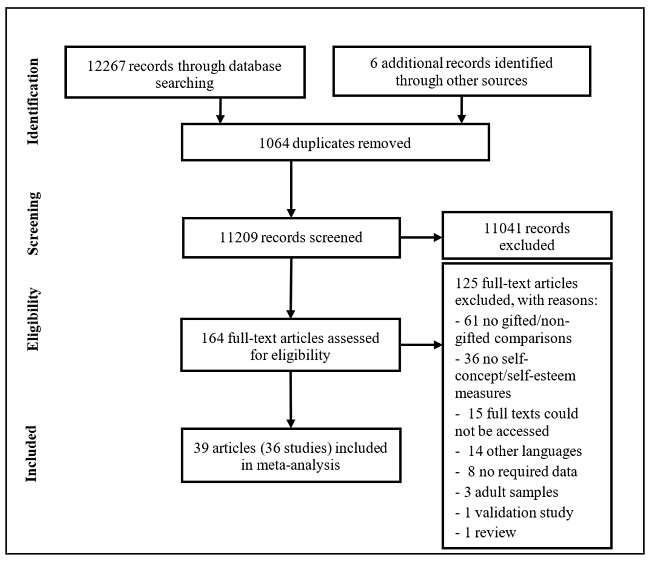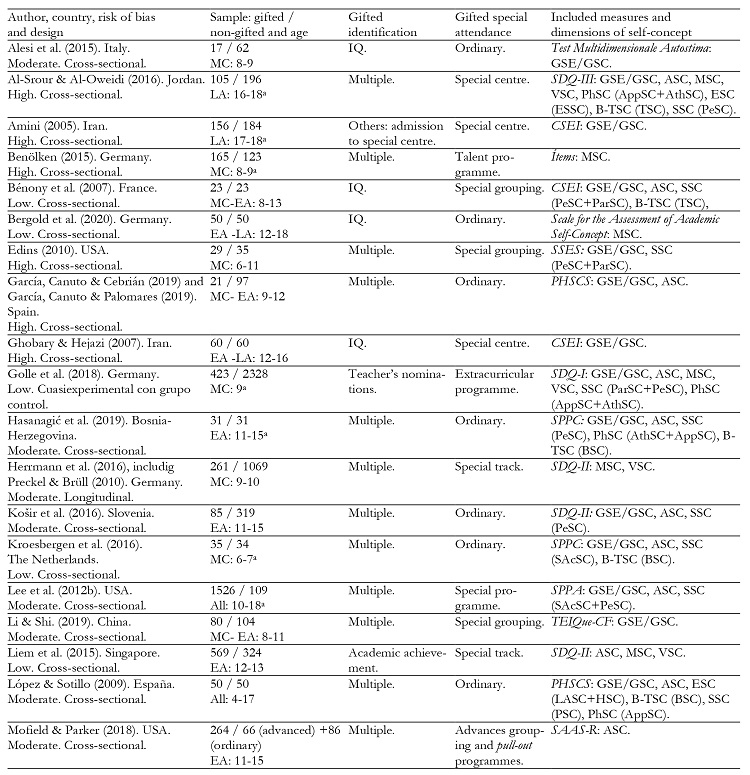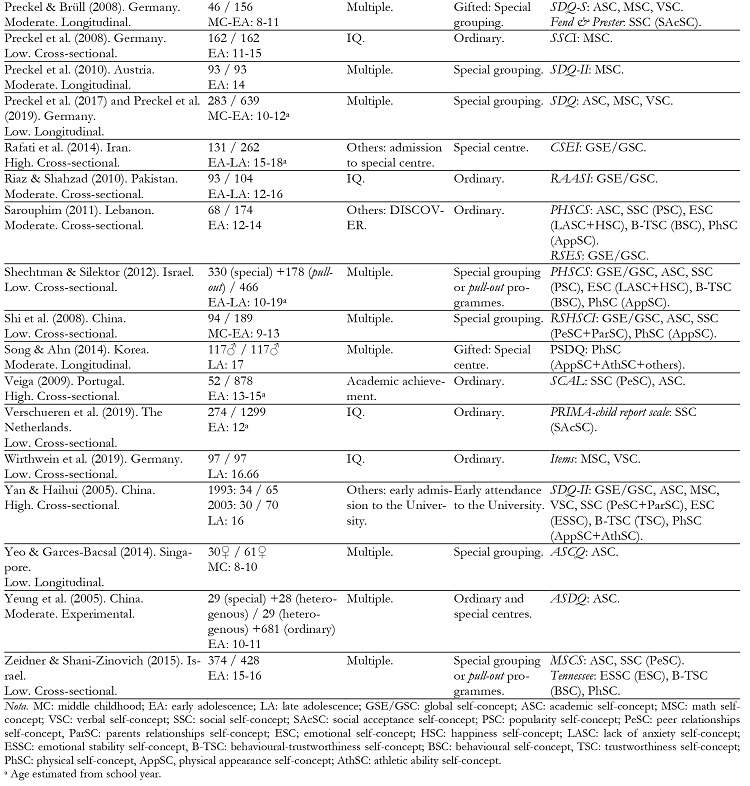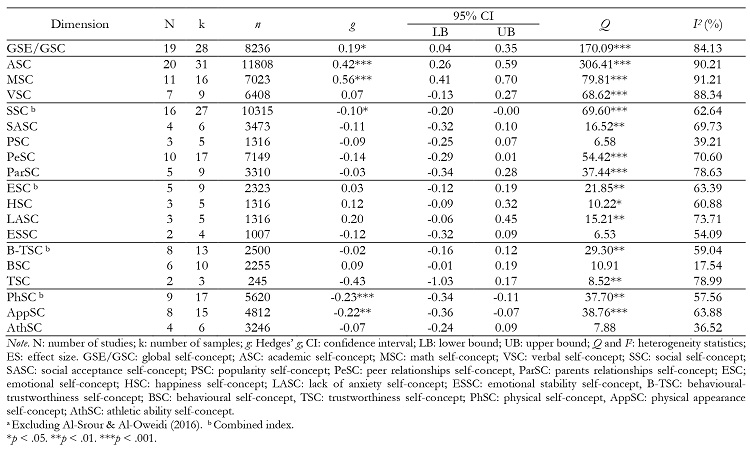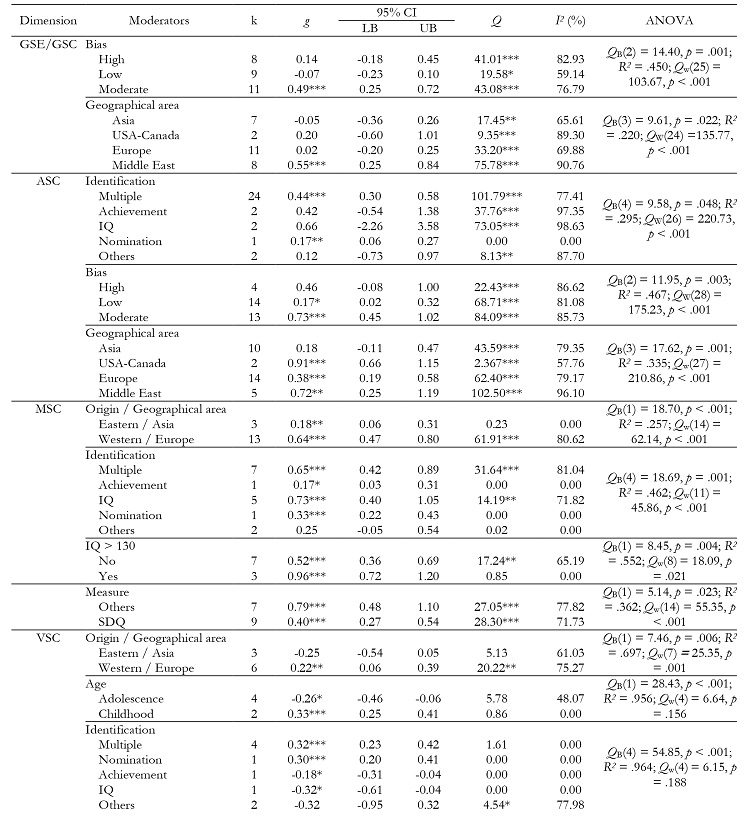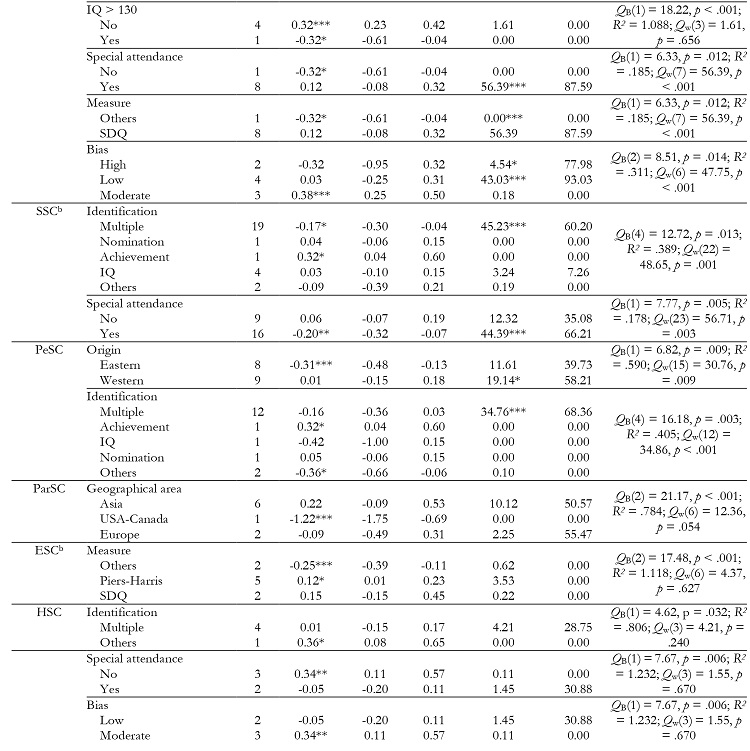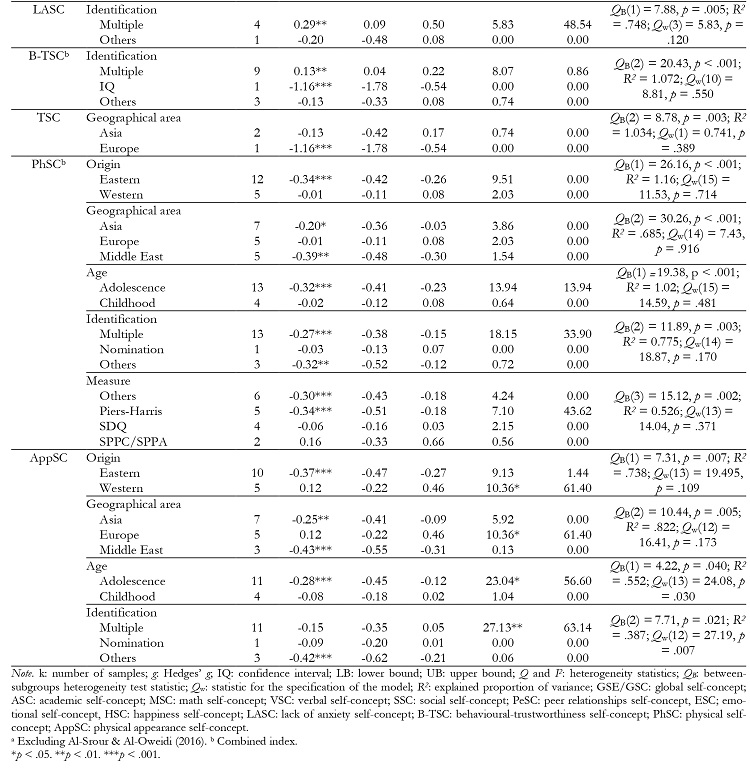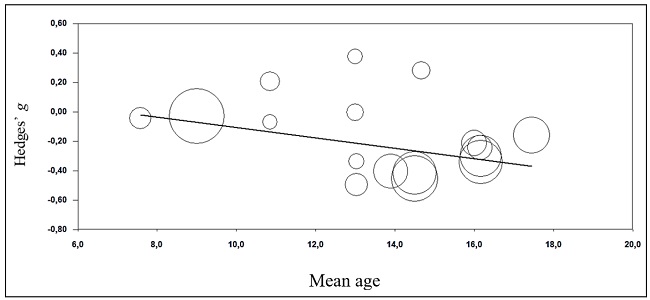Introduction
Gifted students can be defined as those individuals who are more likely to achieve extraordinary or outstanding goals in one or more domains that are culturally recognised by society (Pfeiffer, 2017). Gifted students have an asynchronous development - i.e., their cognitive development is faster than others such as their emotional and physical development-, and this makes them display special social and emotional characteristics (Rinn & Majority, 2018). Numerous studies have addressed whether gifted students have higher or lower levels of socioemotional adjustment than their non-gifted peers in different constructs such as emotional intelligence (Alabbasi et al., 2020), personality (Peperkorn & Wegner, 2020) or perfectionism (Stricker et al., 2019). However, differences on socioemotional characteristics between gifted and non-gifted students are still under discussion (Alabbasi et al., 2020). This is especially relevant nowadays because not only has the number of studies on giftedness increased exponentially (Gürlen et al., 2018), but the concept of “giftedness” itself has evolved together with its identification methods (Acar et al., 2016; Hodges et al., 2018).
Throughout the years, the conception of giftedness has evolved from a general-domain, intelligence-centered perspective (Acar et al., 2016) to a more specific-domain, talent-development approach which considers not only cognitive factors, but developmental, contextual, and non-cognitive factors (Stenberg & Kaufman, 2018). Consequently, the identification of gifted students, which was traditionally based only on IQ or achievement measures, also includes nowadays other instruments such as nominations or portfolios (Acar et al., 2016). Today, traditional and non-traditional procedures coexist and, although they are still far from identifying the majority of gifted students, they make it possible to recognise those gifted students who were traditionally left out (Hodges et al., 2018). It should be noted that this paper uses the term "giftedness”, which in Spanish is literally translated as "altas capacidades" (Tourón, 2020) and, therefore, refers to all those individuals considered talented, highly able, or traditionally referred to as "gifted". It also considers any conception of giftedness that has been followed in the reviewed studies.
Self-concept is an indicator of psychological well-being which has been used in numerous studies on gifted students. “In very broad terms, self-concept is a person's perception of himself” or herself (Shavelson et al., 1976, p. 411). As it is a construct that has been thoroughly studied there are numerous theories and models about it (Van Zanden et al., 2015), the most well-known of which was that proposed by Shavelson et al. (1976). According to this model, self-concept is a multidimensional, hierarchically-structured construct in which global self-concept is on the top of the structure and, at a lower level, there are different specific dimensions: academic, emotional, physical, and social. These dimensions also involve more concrete subdimensions like the math and verbal self-concept within the academic self-concept, or the physical appearance and athletic ability within the physical. An individual’s self-concept is formed through specific experiences and, as they grow older, the self-concept’s structure evolves and becomes more complex due to the apparition of new subdimensions within each dimension (Shavelson et al. 1976; Van Zanden et al., 2015). A person can therefore show different levels in the various self-concept’s dimensions according to their experiences and feelings (Van Zanden et al., 2015).
Among gifted students, a low academic self-concept has been traditionally pointed at as one of the main causes of underachievement (Blaas, 2014), although this association is not always evident (see Gilar-Corbí et al, 2019; Mofield & Parker, 2019). As any other student, gifted students present a heterogeneous reality in self-concept (Villatte et al., 2014). But do they differ from their non-gifted peers in self-concept? To this day, two meta-analyses (Hoge & Renzulli, 1993; Litster & Roberts, 2011) have gathered evidence on this issue. The results showed that gifted students reported overall better levels on global, academic, and behavioural self-concept. On the contrary, they showed lower physical self-concept. Beyond these differences, the authors suggested the existence of variables which moderated these differences and may be addressed in more detail in future studies.
First, the last meta-analysis (Litster & Roberts, 2011) showed the fact that when the methods to designate gifted students were multiple, the samples reported greater differences in self-concept compared to those in which a single measure (i.e., only IQ) was used. The non-traditional methods of identification, such as only nomination or achievement, as well as only IQ and the multiple criteria, should be taken into consideration. Furthermore, intelligence could be moderating the effects of interdimensional comparisons in self-concept (Steinmayr & Spinath, 2015), which is why it is interesting to explore the role of IQ as a moderator within the differences in each dimension.
Moreover, gifted programming also moderates the differences between gifted and non-gifted students’ global self-concept (Litster & Roberts, 2011): The studies reported that those gifted participants who attended a gifted programme in school showed higher levels of global self-concept than those students who did not. A recent review found positive socioemotional effects in school and extracurricular enrichment programmes among gifted students (Kim, 2016). It should be noted that there has been an increased focus on self-esteem issues at educational level in recent years, suggesting that these actions may be having an impact on young people's self-concept levels (Orth et al., 2018). Concern for emotional well-being has been lately a central theme in school programmes for the gifted, according to some reviews (Kim, 2016). However, these did not specify the effects on self-concept and its different dimensions. Therefore, a new review of the last years of research is required.
What is more, recent evidence based on gender differences in non-gifted students confirms that the levels of academic self-concept have been following patterns consistent with stereotypes over generations, despite the narrowing of the achievement gap (Parker et al., 2018). The gifted population also has a number of stereotypes and myths (Baudson, 2016) which may be having an impact on different levels of self-concept to some extent in the last years. Comparing the recent years with the scores found in previous reviews could also help to shed light on the results.
As the last published review on the topic covered up to 2004 (Litster & Roberts, 2011) and has some limitations, such as the lack of a study of the risk of bias, more specific subdimensions of self-concept or differences according to the geographical area of the research, reviewing the current literature on the socioemotional characteristics of gifted students is highly recommended, especially in terms of self-concept. The most recent studies (e.g., Košir et al., 2016; Song & Ahn, 2014) have considered more concrete issues which are not only circumscribed to the measure of global self-concept, but also to other dimensions such as physical or social, as well as other subdimensions. These results may be useful for the development of more accurate interventions and are yet to be synthesised despite the existing need (Steenbergen-Hu & Olszewski-Kubilius, 2016). In addition, research in this area also points to other possible moderators such as geographical area, considering the increase of studies coming from Eastern areas (Gürlen et al., 2018) or measurement instruments for self-concept and gender. Although already researched by Litster & Roberts (2011), recent studies highlight the different historical trends in gender differences (Parker et al., 2018) and thus the interest in reviewing recent years of research.
Considering the above, the present meta-analysis aimed to examine the evidence on the differences in self-concept between gifted and non-gifted students collected from 2005. It was also aimed to enquire into the differences in the subdimensions of self-concept and to test the possible moderator role of some elements pointed out by the literature. This would help to identify useful areas of concern and strengths for teachers and experts (Litster & Roberts, 2011). Also, the differences in the physical self-concept were highlighted since this was an area rarely researched among gifted students and where they have traditionally scored lower than their non-gifted peers.
Methods
The present systematic review and meta-analysis were conducted under the recommendations by Steenbergen-Hu & Olszewski-Kubilius (2016) and the guidelines of PRISMA (Moher et al., 2009) and Rubio-Aparicio et al. (2018). The protocol was previously registered in PROSPERO (ID number: CRD42018094723). The PRISMA checklist can be found in the supplementary material.
Eligibility Criteria
Before the search, the following inclusion criteria were established: a) at least one measure of a global or specific dimension of self-concept or self-esteem would be included; b) the participants would be children, preadolescents or adolescents; c) gifted and non-gifted students would be compared or, at least, sufficient data would be reported to make these comparisons possible; and d) the study would be written in English, Spanish or French. This expanded the range of eligible studies compared to previous meta-analyses (Hoge & Renzulli, 1993; Litster & Roberts, 2011). Only the studies which met these criteria were selected for the review as long as they were published from 2005 onwards, as the previous published review covered up to 2004. Furthermore, those studies meeting the inclusion criteria but whose gifted samples were twice-exceptional students (i.e., participants were gifted and any other learning problem or disability) were excluded. Studies were also excluded if the non-gifted samples were only composed of low-ability students or students with learning problems.
Study search procedures
Different search strategies were designed according to the databases by following the PICO(S) structure (Moher et al., 2009). Five databases were reviewed from their inception until 9 November 2020 at full-text level: Education Resources Information Center, Psychological Abstracts Index, Academic Search Complete, Web of Science and Scopus (Table S1a in supplementary material). Furthermore, five specialised journals were also reviewed since they are some of the most-cited journals on gifted research (Gürlen et al., 2018): Gifted Child Quarterly, High Ability Studies, Journal for the Education of the Gifted, Journal of Advanced Academics and Roeper Review (Table S1b). To avoid mistakes in the search process and the loss of potential eligible studies, the researchers did not use the screening tools available in the databases. The search was not limited to published articles.
Two reviewers randomly screened 1000 of the complete records found after removing duplicates. The inter-rater agreement was very high (Cohen’s κ = .91), therefore, one reviewer continued to screen the rest of records. The full texts and data to be included in the meta-analysis were gathered through the library services of the University of Castilla-La Mancha and by contacting the authors when possible.
A total of 11,712 records were found in the different databases and 555 from the specialised journals. Another six were also added from grey literature. After deleting the duplicates and screening the titles, abstracts and full-texts, 39 articles comprising 36 studies were included for the meta-analyses (Figure 1).
Cross-sectional and longitudinal studies were mainly included due to the aim of the study. Additionally, those studies including an intervention design (i.e., experimental or quasi-experimental) but also considering a comparison group of non-gifted participants were included. Longitudinal and interventional studies were treated as cross-sectional in the quantitative comparisons by only including the data gathered from the first wave.
Coding of variables
The following information was extracted and coded from each of the studies including the following: a) publication year; b) country; c) study design; d) participants’ sex (i.e., male, female or both); e) age according to the WHO categorisation (Cohen et al., 2014)-middle childhood (6 to < 11 years), early adolescence (11 to < 16 years) and late adolescence (16 to < 21 years)-; f) procedures for gifted identification-multiple criteria, only IQ, only nomination, only achievement or others (e.g., early admission to university or other instruments)-; g) attendance or enrolment in special programmes for gifted students-enrichment groups or classes, curricular enrichment, summer programmes, pull-out programmes, or heterogeneous groups. -; h) self-concept measurement instrument; and i) measured dimensions of self-concept. In terms of dimensions, both global self-concept and self-esteem have been considered as a single construct according to Shavelson et al. (1976). In addition, for the research on the studies’ origin as a moderator, a first analysis was carried out by dividing the countries of the studies into Western and Eastern, and a second, more precise analysis by geographical area based on the distribution followed in Pfeiffer et al. (2018). On the other hand, due to the impossibility of dividing the samples by age in some studies, analyses were conducted considering only childhood and adolescence (early and late adolescence) as subgroups. Those studies whose age ranges included all the categories or part of both groups were excluded from the ANOVA analysis. Nevertheless, meta-regression analyses with mean ages were also used. Finally, due to the wide heterogeneity in the categories within special grouping or programmes and the low number of studies that accommodated many of them, the studies were reorganised into two subgroups: those gifted samples that attended any kind of special grouping or interventions, and those that did not.
Regarding the statistical data, as some studies reported data allowing for several effect sizes (ES) to be computed, the assumption of their independence could be violated (Card, 2012). Thus, we created several independent subsets (Becker, 2000). Except in the case of global and academic self-concepts, where a large number of studies existed, the different scales measuring similar or related constructs were added for the study of each of the main dimensions according to Shavelson et al.'s (1976) model: social self-concept, emotional self-concept, physical self-concept, and behavioural-trustworthiness self-concept. For instance, to find the physical self-concept index, the measures of physical appearance self-concept, athletic ability self-concept and other physical subdimensions were considered. Moreover, subset analyses of the subdimensions were conducted separately: math self-concept, verbal self-concept, self-concept in social acceptance, popularity, peer relationships, relationships with parents, happiness, lack of anxiety, emotional stability, trustworthiness, behavioural, physical appearance, and athletic ability.
Risk of bias in the individual studies
The risk of bias of each of the included studies was assessed by two reviewers using a tool for observational studies (Viswanathan & Berkman, 2012), which was adapted for the purposes of this meta-analysis (Table S2a). According to the sum of their scores on the selected items, the studies could reach a maximum score of 30 points. These were individually classified as “high”, “moderate”, or “low” risk of bias if the studies reached a total score of < 50%, ≥ 50% to < 75%, or ≥ 75%, respectively. This classification was considered in the moderator analyses. The first two reviewers randomly assessed seven of the included studies, reaching substantial interobserver agreement (κ = .75), so the first reviewer continued to assess all studies and any discrepancies were resolved by consensus. These results can be found in the supplementary material (Table S2b).
Effects sizes and statistical analyses
Hedges’ g was the statistic used for the calculation of the ES. It is calculated in a similar way to Cohen’s d (formula 1), but a correction (formula 2) was applied to reduce the possible bias due to small-size samples (i.e., n < 20 according to Card, 2012). Thus, the extracted data from the studies were the mean, standard deviations and sample sizes, as well as the reported Cohen’s d, which were transformed into Hedges’ g by following formula 2. The magnitude of the ES was interpreted by following Cohen’s (1988) guidelines: small = 0.20 to 0.50, medium = 0.50 to 0.80, and large > 0.80. A positive value of g indicates differences in favour of the gifted students and vice versa.
The statistical analyses were performed with Comprehensive Meta-Analysis Software Version 3.3.070 under the random-effects model in recognition of the differences among the included studies (Borenstein et al., 2007) and weighted according to the sample sizes. Additionally, Q and I 2 statistics were used to measure the heterogeneity of the studies (Borenstein et al., 2007). For the latter, we followed the Cochrane Collaboration’s guidelines (Higgins & Green, 2011) in order to interpret the level of heterogeneity: 0 - 40% not important, 30 - 60% moderate, 50 - 90% substantial, or 75 - 100% considerable. Furthermore, sensitivity analyses were performed (Becker, 2000 )and the publication bias was examined by means of Egger’s test with a level of significance at .10 (Egger et al., 1997). Given the low sensitivity this method presents for meta-analyses containing less than 20 ES, funnel plots and the suggested mean ES were also examined through the trim-and-fill method under a random-effects model (Duval & Tweedie, 2000). The inclusion of these analyses was intended to overcome the methodological limitations of previous meta-analyses which did not perform such analyses on the included studies.
The possible effects of the variables previously identified as moderators were addressed through the QB and QW via an ANOVA-way test. On the other hand, the two continuous moderators were examined by means of independent meta-regression models using the QR and QE statistics to determine the fit and specification of the models, respectively, with those self-concept domains that had at least 10 samples, following the recommendations of Borenstein et al. (2009). In addition, the R2 was found to determine the variance explained by each continuous moderator following the procedures established by Botella & Sánchez (2015).
Results
Descriptive characteristics of studies
The characteristics of the 36 included studies are shown in Table 1. All of the studies were published as articles between 2005 and 2020, except for one doctoral dissertation (Edins, 2010) and one proceeding (Yeung et al., 2005). Most of the studies had a cross-sectional design (n = 28), six were longitudinal studies and only two were experimental (Yeung et al., 2005) and quasi-experimental with control group (Golle et al., 2018) studies. The studies belong to 18 different countries, being Germany the one with the highest number of studies (n = 8).
The sample sizes of the gifted group in the studies varied from 17 to 1,526 participants, with a total of 6,443 gifted participants among all studies, whereas the non-gifted samples varied from 23 to 2,328 participants, amounting to 11,320 non-gifted participants among all studies. The vast majority of studies included samples of both genders, except for Song & Ahn (2014), who only included males, and Yeo & Garces-Bacsal (2014), who only included females, while Veiga (2009) did not specify the gender of the participants. The participants’ age ranged from 4 to 19 years. Fourteen studies included samples of middle childhood, 23 included samples of early adolescents, and 10 studies included late adolescents.
With regard to the gifted students’ samples, most of the studies considered multiple criteria to identify a student as gifted (n = 21), eight studies only relied on IQ measurements, two studies based the identification entirely on academic achievement, and one study only relied on nomination as a single indicator of giftedness. Within the multiple criteria, 15 studies mainly considered IQ plus other indicators and 12 studies considered nomination and other indicators. Furthermore, nine studies reported that their gifted sample presented an IQ ≥130. Most of gifted participants attended special classes or centres for gifted students and/or advanced, enrichment, or pull-out programmes (n = 21), enrichment extracurricular or summer programmes (n = 3), whereas in 12 studies, the gifted students did not attend any special programme or at least it was not reported.
Finally, concerning the self-concept measurement instruments, the most used (n = 11) was the Self-Description Questionnaire (SDQ), including its version on academic (ASDQ) and physical self-concept (PSDQ). The Coppersmith’s and Piers-Harris’ scales were each used in four studies. The Self-Perception Profile for Children (SPPC) and Adolescents (SPPA) were included in three studies. The remaining 14 studies applied other measurements of self-concept (Table 1).
Meta-analyses’ main results
The 36 studies included in the meta-analyses reported a total of 180 ES. Initially only small significant differences were found in global self-concept (g = 0.24; 95%CI = 0.06, 0.41), medium differences in academic self-concept (g = 0.45; 95%CI = 0.28, 0.63) and medium-large in math self-concept (g = 0.60; 95%CI = 0.44, 0.76). Gifted students scored higher than their non-gifted peers on these dimensions. In all other dimensions no significant differences were found. However, heterogeneity was significant, reaching substantial and considerable rates, except in the popularity and behavioural dimensions. Therefore, sensitivity and moderator analyses were performed. Following the sensitivity analyses, it was observed that the exclusion of Al-Srour & Al-Oweidi’s (2016) study led to significant changes in the mean ES for most of the non-academic dimensions as well as a notable decrease in their heterogeneity. All analyses including this study can be found in Table S3 in the supplementary material. Considering the high level of risk of bias found in this specific study, it was excluded for the analyses in all dimensions. Table 2 lists all final mean effect sizes for each dimension.
Results by dimension
The final results for each dimension are presented hereinafter. Given the extension of the work, only the significant results of the moderator analyses by ANOVA (Table 3) and meta-regression (Figure 2) are reported; the rest are included in the supplementary material (Tables S4 and S5).
Global Self-Concept / Self-Esteem
The 19 studies addressing global self-concept showed that gifted students scored significantly higher than non-gifted students, with a small difference (g = 0.19; 95%CI = 0.04, 0.35) however, and considerable heterogeneity (I2 = 84.13%). The geographical area was found to be a significant moderator indicating that only the studies from the Middle East showed significant differences, although the model explained only 22% of the variance of the ES. On the other hand, the risk of methodological bias also proved to be a significant moderator, with differences only among studies of moderate quality, with this model accounting for 45% of the variance.
Academic Self-Concept
Academic self-concept was analysed by 20 studies showing moderate differences in favour of gifted students and considerable heterogeneity. Moderators explaining this heterogeneity included risk of bias, showing significant differences only between low and medium risk studies; geographical area, indicating that studies from Asia did not show differences between gifted and non-gifted students; and method of identification, where gifted students showed higher levels when the selection criteria were multiple or nomination, although the latter case only had a very small ES sample.
The differences in math self-concept were also analysed with 11 studies and in verbal self-concept with seven studies, showing significant and medium-sized results only in the first of them and in favour of gifted students, although in both cases heterogeneity was considerable. Among the moderators were the origin of the studies, the methods of identification and the self-concept measurement instrument. From the three of them, identification methods reported a higher percentage of variance in both dimensions (46.2% in math and 96.4% in verbal). In math self-concept, gifted students scored higher in all subgroups except those identified by "other procedures"; the differences were medium-large for those identified by an IQ test. Similarly, in verbal, all subgroups showed significant results except for samples identified by other procedures, although those based on IQ or nomination showed lower levels among gifted students with small ES. As for the measurement instruments as a moderator in math self-concept, although the differences were significant in all cases, they were smaller among those who used the SDQ compared to other instruments. On the other hand, in verbal self-concept the differences were not significant in the SDQ subgroup. Finally, among those samples reporting IQ, the cut-off point of 130 also moderated these differences, with much higher scores in math self-concept among those gifted students above this cut-off point; in the case of verbal, however, the model saturated due to the low number of studies in the subgroups (R2 > 1).
In verbal self-concept, in addition to the above, age by category significantly moderated the mean ES, with gifted students scoring higher in childhood and lower in adolescence and explaining a large part of the model (95.6%). Other moderators were participation in special grouping, although only one sample did not participate in special grouping, and risk of bias (Table 3).
Social Self-Concept
The 16 studies that included some measure of social self-concept reported significantly lower levels among gifted students, although the differences were very small and there was substantial heterogeneity. Within the social dimension, other subdimensions addressed were social acceptance, popularity, relationship with peers, and relationship with parents; in none of these did gifted students differ from non-gifted (p > .05), although only in the case of popularity heterogeneity was not significant.
Among the possible moderators, identification procedures explained 38.9% and 40.5% of the variance in social self-concept and peer self-concept respectively. Those gifted students identified by multiple criteria only had significant scores on social self-concept, with slightly lower levels among gifted students; while on peer self-concept only those gifted students identified by other procedures scored significantly lower and those identified by achievement scored significantly higher, although the number of samples in each subgroup was very low. On the other hand, participation in special groups also moderated social self-concept, showing that those gifted students in special groups had lower levels of social self-concept than non-gifted students, explaining only 17.8% of the variance. Finally, with regard to geographical area as a moderator, it was found that only gifted students from Eastern countries scored lower than non-gifted on self-concept in peer relations. Although this moderator was also significant for self-concept in the relationship with parents, only the gifted students from the single sample from the USA scored significantly lower than their non-gifted peers.
Emotional Self-Concept
Five studies were able to address differences in emotional self-concept. No differences were found between gifted and non-gifted students on the overall index, nor on the self-concept subdimensions of happiness, lack of anxiety and emotional stability. Heterogeneity was moderate-substantial, except for emotional stability, where it was not significant.
On the overall emotional self-concept index, the measuring instrument was the only significant moderator, indicating that there were no differences between gifted and non-gifted students in those studies that used the SDQ to measure this dimension, while gifted students scored slightly higher on the Piers-Harris scale and lower when other instruments were used. However, the ANOVA model saturated due to the low number of studies of the subgroups. With regard to self-concept in happiness and lack of anxiety, small differences were found between those identified by multiple criteria and those identified by other criteria; however, the low number of studies does not allow us to corroborate this moderator with certainty. Finally, on self-concept in happiness, significantly higher levels were found only among those gifted students who did not attend a special group and in those studies with moderate risk of bias.
Behavioural Self-Concept
The combined behavioural and trustworthiness self-concept index, consisting of eight studies, did not show any significant differences between gifted and non-gifted students. Neither did the behavioural and trustworthiness subdimensions independently. Significant levels of heterogeneity were found in the combined index and in trustworthiness self-concept.
In the first case, identification indexes were noted as a significant moderator, with small differences found only between those identified by multiple criteria and those by IQ as the only criterion. The differences were in favour of gifted students in the first case and in favour of non-gifted students in the latter, although the ANOVA model saturated. In the case of trustworthiness self-concept, geographical area seemed to moderate the differences, although the low number of studies by subgroups also led to saturation in the model.
Physical Self-Concept
The 17 studies addressing physical self-concept found that gifted students scored significantly lower than non-gifted, although these differences were small. The results were similar for the physical appearance subdimension, while there were no differences in the athletic ability subdimension. Furthermore, only general physical self-concept and physical appearance self-concept showed significant and moderate heterogeneity.
In both physical self-concept and physical appearance self-concept, geographical area, age and identification criteria were significant moderators. Regarding the first of them, it was reported that only gifted students from Eastern countries scored lower on both indexes. As for the identification methods, in both cases the nomination-based subgroup showed smaller differences than the others, without really being significant. Furthermore, in self-concept in physical appearance it is noteworthy that only gifted students identified by criteria different than nomination or the use of multiple criteria scored lower than non-gifted students, with a small-to-moderate difference, while in general physical self-concept this is also the case for those identified by multiple criteria. Finally, in physical self-concept the instruments moderated the differences, reporting significant results with the Piers-Harris scale and the subgroup composed of other instruments.
As indicated, age was also a moderating variable in both general physical self-concept and physical appearance, with significantly lower levels only among adolescent gifted students. In the case of the general physical self-concept index, meta-regression analyses (Table S5) corroborated that age was a moderating variable, this being the only correctly specified model (intercept = .247 (p = .261), bj = -.035 (p = .024), QR(1) = 5.11 (p = .024), QE(15) = 20.31 (p = .160), R2 = .67) and showing how the differences become larger as the samples are older, and how gifted students score increasingly lower in comparison with non-gifted (Figure 2).
Risk of Bias
After performing Egger's test on each of the dimensions (Table S6), it was found that the results of the math, social acceptance, emotional stability, behavioural-trustworthiness, and behavioural dimensions may present publication bias (p < .10). However, for the math and behavioural-trustworthiness dimensions, the trim and fill method did not impute new ES, so publication bias was not confirmed for these dimensions. On the contrary, for the dimensions of social acceptance (g = 0.05; 95%CI = -0.20, 0.29), emotional stability (g = -0.25; 95%CI = -0.47, -0.02) and behavioural (g = 0.11; 95%CI = -0.01, 0.23) publication bias was confirmed after the imputation of two new values and the adjustment of the mean values, so these results should be considered with caution.
Discussion
The present meta-analysis has focused on differences in self-concept between gifted and non-gifted students as well as the identification of possible moderators of these differences. This paper builds on previous meta-analyses (Hoge & Renzulli, 1993; Litster & Roberts, 2011), offering an analysis of 36 new studies published since 2005, in search of a deeper look into the results by analysing subdimensions of self-concept and including risk of bias analyses. Consistent with these earlier studies, the results showed that gifted students had higher levels of global and academic self-concept and lower levels of physical self-concept compared to their non-gifted peers. However, contrary to previous meta-analyses, the results have shown lower levels in the social domain among gifted students, especially in those groups where gifted students attended specific centres or groups, although the differences were small, and there were no differences in behavioural self-concept.
This study has also addressed behavioural-trustworthiness self-concept and emotional self-concept, indexes which were not included in previous meta-analyses. In none of the cases were significant results found, neither in the combined indexes nor in the individual indexes; however, the results are based on a low number of samples (n < 10) and therefore they cannot be considered conclusive. The results of the significant differences are discussed below.
With regard to the academic dimension, math self-concept showed the largest difference between gifted and non-gifted students, followed by academic self-concept, and no differences were found in verbal self-concept. These results seem consistent with the Internal/External Model (Möller et al, 2016), although it is important to point out that academic achievement in math and verbal areas has not been addressed in this meta-analysis, which would be a requirement to be able to confirm this model. Despite this, a previous study already indicated a more pronounced effect of the Internal/External Model among gifted students compared to non-gifted, suggesting that intelligence may be moderating the effect (Steinmayr & Spinath, 2015). The moderating role of IQ ≥ 130 in math and verbal self-concept highlighted in this meta-analysis supports this idea, although in the case of verbal self-concept the subgroup above the IQ cut-off point was only composed of one study, so the evidence is limited.
As for the social dimension, in general the gifted students were significantly lower on the combined index, although the difference was negligible. According to moderator analyses, there were differences only among those who participated in special programmes for gifted students. This contrasts with evidence finding higher levels of social self-concept in gifted students who participate in such programmes (Lee et al., 2012a). However, decreases in this dimension have also been found when students have been in special programmes or groups for some time, reaching lower rates than non-gifted students or gifted students in heterogeneous groups (Preckel & Brüll, 2008; Vogl & Preckel, 2014), suggesting that habituation or competitiveness in achievement could be the causes. There are no specific differences in perceived popularity and social acceptance between gifted and non-gifted students. Such discrepancies between social dimensions have been reported in previous studies, where there were mainly two profiles of gifted students when describing themselves: those with a strong sense of difference, and those who showed a desire to sympathise with others (Villatte et al., 2014).
Regarding the physical dimension, the difference in physical self-concept is larger than that found by Hoge & Renzulli (1993) and the difference in self-concept of physical appearance is larger than that found by Litster & Roberts (2011), whereas there was no difference in self-concept in athletic ability. According to Cohen's (1988) criteria, these are small differences. In fact, it was stated that gifted students were not at significant risk of problems with their physical self-concept (Litster & Roberts, 2011). However, these authors warned that these lower physical perceptions "may limit the activities in which gifted students choose to participate" (p. 137). This is an important issue, as healthy levels of physical activity are associated with psychological well-being through their positive relationship with physical self-concept (Babic et al., 2014), one of the most important dimensions for global self-concept in adolescents (Baudson et al., 2016).
Previous research has already indicated that gifted students who participate in sports show better levels of physical self-concept, especially in athletic ability, than gifted students who do not participate (Rinn & Wininger, 2007). One might wonder whether gifted students show lower levels of physical activity or fitness than non-gifted students, but the scarce literature about the topic denies this suggestion (Hormázabal-Peralta et al., 2018). In fact, one of the included studies (Song & Ahn, 2014) showed that gifted students, despite having higher objective levels of physical activity and fitness, had similar levels on the different subdimensions of the physical self-concept to non-gifted students. All this seems to confirm that gifted students show a generally lower physical self-concept than non-gifted students, regardless of their levels of physical activity and fitness. However, as discussed in the previous meta-analysis, why does the positive trend in academic self-concept not transfer to physical self-concept? As suggested by Song and Ahn (2016) and Baudson (2016), the Generalised Internal/External Model could explain such inconsistencies (Möller et al., 2016) through the positive effect of academic achievement on academic self-concept and its negative effect on physical self-concept. However, this cannot be proven with the current results of this meta-analysis as it refers to intra-individual differences and not to group mean differences. Furthermore, it would be necessary to consider actual performances.
The answer to the question may be determined by moderators. On the one hand, the differences were only smaller among gifted students when Eastern countries were considered. Consistently, research has found cultural differences in adolescent athletes' self-concept of physical appearance, with lower levels among Eastern samples (Asghar et al., 2013), as well as lower levels on other dimensions among Eastern gifted students compared to Western gifted students (Lee et al., 2012a). On the other hand, lower levels of physical appearance self-concept were found among gifted students in adolescence, but not in childhood, and in fact, meta-regression analyses were able to corroborate how as the samples get older gifted students have lower physical self-concept scores than non-gifted, explaining 67% of the variance. As the individual grows older, self-concept evolves and changes, especially during adolescence, where some gender differences can be found which that are consistent with gender stereotypes (Van Zanden et al., 2015). Similarly, intellectual ability might entail some differences in self-concept development linked to stereotypes. Gifted students are a population surrounded by myths that still remain in the cultural heritage (Baudson, 2016). In fact, they have been seen as physically weak and "unattractive nerds" by their peers (Rudowicz, 2007). It has even been found that teachers are more likely to describe an imagined gifted student as having a non-athletic complexion than a standard or athletic complexion (Carman, 2011). Taking stereotypical views of giftedness into consideration may lead gifted students to over-identify with their area of talent (Cross, 2005), so that these individuals might end up perceiving their appearance as described through these stereotypes, leading to a more devalued physical self-concept.
Finally, it is worth pointing out that in most dimensions the gifted students’ identification criteria have emerged as a significant moderator, yet without a clear pattern. In several dimensions their effect appears to be consistent with the results of Litster & Roberts (2011), reporting larger differences in those where different methods of identification were employed. However, in most cases the nomination subgroups, IQ-only or achievement-only, were based on a single study, so the results are inconclusive. Despite this, there are meta-analyses (Acar et al., 2016; Hodges et al., 2018) showing how different identification methods recognise different types of gifted students. These results could therefore be indicative of heterogeneity among gifted students caused by the use of different identification procedures.
Limitations
The main limitation was the impossibility of accessing the necessary data for meta-analysis of some of the identified studies. Furthermore, the low number of studies in many of the subgroups, as evidenced by the saturation of the models in the moderator analyses, and the significant levels of heterogeneity in the subgroups compromise the possibility of reaching conclusive results on many of the dimensions of self-concept. The reason may be the wide variety of identification procedures. Finally, nine studies were assessed with a high risk of bias due to lack of information on differences by gender or dimension, and the reliability, validity or uniformity of the measures used for the identification of gifted students (Table S2b); and a possible publication bias was detected in the dimensions of social acceptance, emotional and behavioural stability.
Conclusions
The results of the present meta-analysis corroborate the presence of higher levels of global and academic self-concept among gifted students that previous literature has already indicated. However, a review of the most recent research further echoes the difficulty in comparing between samples chosen using disparate criteria and from different geographical contexts in the study of self-concept in gifted students, which had already been suggested by previous reviews. In addition, it should be noted that there is little evidence addressing the physical dimension and a lack of research focused on the reasons that may explain the presence of lower levels in this dimension among gifted students. In this sense, the present study offers two important clues which help to understand this issue: age and culture. Therefore, it is necessary to investigate the role of social stereotypes and physical activity habits on the self-concept of gifted students, without neglecting the possible effects of dimensional comparisons proposed in previous research.











 texto en
texto en 

